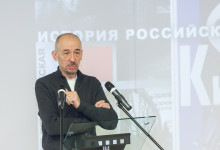
Premiere screening of the “White Hot Chaos” movie of Sergey Debizhev as an anthology of the 1917 revolution — in the Presidential Library
The Presidential Library Cinema Club will meet for a premiere screening and a discussion of the documentary by Sergei Debizhev entitled “White Hot Chaos” shot on the occasion of the centennial of the 1917-year Revolution in Russia.
Apparently, at the lapse of a century this case cannot be considered closed, being re-interpreted by every other generation of filmmakers. The director of Lendok Studios Sergei Debizhev — a St. Petersburg based graphic artist who started his work in film production with documentary projects of Alexander Sokurov, and a film direction of the cult “Aquarium” group’s video on their song “This train is on fire,” could never avoid this theme least of all. “White Hot Chaos” is an offspring of the director’s many years long revision of the fate of his native land. This film came out after such his works as “Russian Dream” and “The Last Knight of the Empire,” already familiar to the audience of the Presidential Library Cinema Club.
Before the screening Sergei Debizhev said: “I see young faces in the movie theater today — this is important. It is principal to know, whom the future will belong to. The future cannot be figured out while sitting behind your desk. It begins in a deep imaginative interpretation of entire historical experience. Filmmakers faced such task working on our movie. And the spectator’s task is to think out, to understand its text and covert sense, to get his own idea of the most important things.”
The new film of Debizhev largely relies on fragments of the book “Russia of 1917 in ego-documents. Recollections” of a large team of authors of the Institute of History and Archeology of the Ural Branch of the Academy of Sciences. A volume of works compiles the memories about the revolution, written by different people at different times and therefore allows looking at the bygone events from different, sometimes even polar positions. Author’s voice-over interweaved with the voices of the long-dead eyewitnesses of the epoch.
The director drew attention to the sociocultural processes, in which Art Nouveau was on the leading position. This influenced the style of the filmmaking of “ White Hot Chaos.”
A sequence of frames filigree composed of photographs and newsreels of past years, combined with the fragments of Soviet feature films about the revolution released by such directors as Pudovkin, Romm, Eisenstein — according to Debizhev, he spent 7 months at the editing desk. The rate of “moving pictures” is very fast. All together it demonstrates the authors’ style never accustomed to flirting with the viewer, rather pursuing authors’ own aesthetic and ideological goals.
An important role in the movie belongs to the sounds of an obsessive, accelerated loud clattering of a flywheel of revolution, including the knocking of pistons and other parts of the engine of the “Aurora” cruiser, which is powerfully floating into the frame.
Shortly before the screening night within a next in turn scheduled cinema club in the Presidential Library, the movie “White Hot Chaos” won the Grand Prix of the “Radonezh” Film Festival, a well-recognized leader in the field of the religious, spiritual and ethical documentary. Traditionally, about two hundred state sponsored and non-state film production and television studios both native and foreign take part in the festival.





